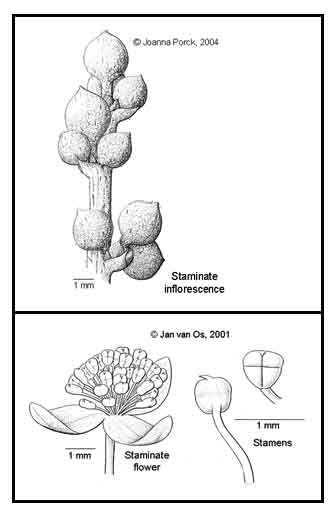
Family • Euphobiaceae
Saligao
Cleidion javanicum Blume
San tai hua
| Scientific names | Common names |
| Acalypha spicigera Klotzsch | Agipos (Tag.) |
| Cleidion javanicum Blume | Hantatampsi (C. Bis.) |
| Lasiostylis salicifolia C.Presl. | Kayugkog (Tag.) |
| Macaranga tamiana K.Schum. | Lapo-lapo (Ilk.) |
| Rottlera urandra Daizell | Malagasaba (Tag.) |
| Tanarius tamianus (K.Schum.) Kuntze | Malatuba (Bik.) |
| Tetraglossa indica Bedd. | Saligao (Tag.) |
| Tragia filiformis Poir. | Tayokan (Tag.) |
| Above scientific names are from The Plant List. | |
| Cleidion javanicum Blume is an accepted name. The Plant List | |
| Quisumbing's compilation lists Saligao with the following scientific names: Acalypha spiciflora Burm.f., Cleidion spiciflorum (Burm.f.) Merr., Cleidion javanicum Blume, Lasiostylis salicifolia C. Presl. | |
| A revision of the Malesian species in the genus Cleidion is presented. Cleidion javanicum is shown to be the correct name for the widespread type species (instead of the name C. spiciflorum). (5) | |
| The Plant List lists Cleidion spiciflorum as a synonym of Acalypha spiciflora Burm.f. (an unresolved name). | |
| Some of the sources for studies below list C. javanicum and C. spiciflorum as synonyms. | |
| Other vernacular names |
| CHINESE: Bang bing hua, San tai hua. |
| MALAYALAM: Yellari. |
| THAI: Di mee, Dimi, Kamlai, Kaadaao krachaai, Ma-dee-mee, Maj maduug. |
| VIETNAMESE: Phân loại khoa học, Mo chim, com gao. |
Botany
Constituents Properties Availability |
© Godofredo U. Stuart Jr., M.D. / StuartXchange |
Updated March 2021 / July 2018 / April 2016
![]()
 |
PHOTOS / ILLUSTRATIONS |
| IMAGE SOURCE: / Photo / Cleidion javanicum / © Phongsak Phonsena/ click on image to go to source page / Non-Commercial Ude / Flora Malesiana / National Herbarium |
| IMAGE SOURCE: / Line drawings / Cleidion javanicum / © Joanna Porck 2004 / © Jan Van Os 2001 / Click on image to go to source page / Non-commercial use / Flora Malesiana / National Herbarium |
Additional
Sources and Suggested Readings |
DOI: It is not uncommon for links on studies/sources to change. Copying and pasting the information on the search window or using the DOI (if available) will often redirect to the new link page. (Citing and Using a (DOI) Digital Object Identifier) |
• |
| List of Understudied Philippine Medicinal Plants |
 |
• |


 Distribution
Distribution